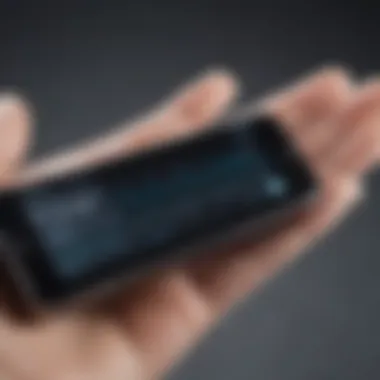Exploring the AliveCor Kardia Heart Monitor


Intro
The landscape of personal health monitoring has evolved significantly in recent years. Among the innovations in this field is the AliveCor Kardia Heart Monitor. This device allows individuals to track their heart health in a user-friendly manner. It translates complex medical data into accessible insights, empowering users to take charge of their cardiovascular well-being. In this article, we will explore the features of the Kardia heart monitor, the clinical research backing its effectiveness, and the implications of its use in telemedicine and personal health management.
Summary of Objectives
The primary objective of this comprehensive review is to analyze the AliveCor Kardia Heart Monitor's role in personal heart health monitoring. It looks into the device's features, effectiveness, and accessibility—all critical factors for both patients and healthcare providers.
Importance of the Research
As heart disease remains a leading health concern worldwide, effective self-monitoring solutions are crucial. This research is particularly valuable for understanding how technologies like the Kardia heart monitor can improve patient outcomes.
Features of the AliveCor Kardia Heart Monitor
The Kardia device offers several features that set it apart from traditional heart monitoring methods. It provides real-time ECG readings in an easy-to-use format. Users can detect arrhythmias, monitor heart rate, and share readings with healthcare professionals. The compact size allows for portability, making it convenient for daily use.
Moreover, the Kardia app enhances the user experience. It integrates seamlessly with the device, allowing users to store and track their data over time. This data can be crucial for informed discussions with healthcare providers.
Clinical Efficacy
Numerous clinical studies have evaluated the validity and reliability of the AliveCor Kardia Heart Monitor. Findings suggest that the device primarily excels at detecting atrial fibrillation. According to research, its accuracy is comparable to standard ECGs used in clinical settings.
"The AliveCor Kardia's ability to provide accurate heart data can facilitate timely intervention, making it a valuable tool in managing heart health."
User Experience and Accessibility
User experience reflects the overall effectiveness of any medical device. The Kardia heart monitor boasts a user-friendly interface and straightforward operation. Users can initiate tests with just a single tap, and the results are available within seconds.
In terms of accessibility, the Kardia device aims to be affordable and widely available, ensuring more people can monitor their heart health. The app is available on both iOS and Android platforms, broadening its reach.
Implications for Telemedicine
As telemedicine continues to rise, devices like the Kardia heart monitor play a pivotal role. They enable healthcare professionals to monitor patients remotely. This capability improves patient engagement and allows for better healthcare delivery, especially for those in remote areas or with limited access to medical facilities.
End
Overall, the AliveCor Kardia Heart Monitor presents a significant advancement in personal heart health monitoring. This review explores its features, clinical efficacy, user experience, and the implications for telemedicine. As we further delve into the details, we hope to inform researchers, healthcare professionals, and patients about this beneficial tool in managing heart health.
Prologue to AliveCor Kardia
The AliveCor Kardia Heart Monitor represents a significant advancement in personal health technology. Its integration into heart monitoring gives patients, researchers, and healthcare professionals a new dimension of data. Understanding the AliveCor Kardia is important not only for grasping its technological framework but also for appreciating its impact on individual health management and clinical practices.
Overview of Heart Monitoring Technology
Heart monitoring technology has evolved dramatically over recent years. Traditional methods like electrocardiograms (ECGs) used in hospitals often rely on bulky equipment and trained personnel. However, devices like AliveCor Kardia bring this monitoring capability into a portable format, enabling real-time assessment of heart health.
This technology employs advanced sensors and algorithms to capture heart activity. It provides data that can be analyzed instantly, making it easier for users to track their health. The significance lies in empowering patients to take charge of their heart health, leading to improved outcomes. Continuous monitoring can help identify irregularities early, prompting timely interventions.
The Genesis of AliveCor


AliveCor was founded with a mission to revolutionize heart health monitoring. The origins of this company are rooted in the intersection of technology and medicine. It started out of a desire to make heart monitoring accessible and less invasive. The founders aimed to bring a clinical-grade ECG to consumer devices.
Since its inception, the Kardia line has undergone several iterations, each improving upon the last. With each model, features have expanded, incorporating better connectivity, enhanced accuracy, and user-friendly designs. This evolution reflects the broader trends in healthcare technology that prioritize patient engagement and outcomes. The commitment to continuous improvement highlights how AliveCor aims to stay at the forefront of heart health innovation.
Technical Specifications
Understanding the technical specifications of the AliveCor Kardia Heart Monitor is crucial for several reasons. They not only showcase the capabilities of the device but also indicate how it fits into the larger framework of personal health management. Evaluating the specifications provides insights into design quality, functionality, and the potential limitations inherent in the device. This section delves into key aspects such as build quality, battery life, and connectivity features, which are fundamental for a comprehensive assessment of user experience and usability.
Design and Build Quality
The design and build quality of the Kardia Heart Monitor reflect its purpose as a reliable tool for home heart health tracking. The device is compact and lightweight, making it easy to carry and operate. Constructed with durable materials, the Kardia offers a sleek and professional appearance, encouraging consistent use by consumers. Its ergonomic design allows for a comfortable grip during measurements, which is essential for accurate readings. Additionally, the placement of control buttons and the display enhances usability, allowing users to navigate functions intuitively. Overall, the thoughtful design contributes positively to user confidence and satisfaction in monitoring their heart health.
Battery Life and Charging
Battery life is a critical consideration for wearable medical devices. The AliveCor Kardia Heart Monitor features a rechargeable battery that, under normal usage conditions, lasts several weeks on a single charge. This longevity allows users to complete their monitoring tasks without frequent interruptions to recharge. The charging process is simple and efficient, using a standard USB cable. Thus, users can charge the device quickly, making it suitable for those with busy lifestyles. Regular use inherently encourages users to keep track of their heart health regularly and empowers them to report any changes promptly.
Connectivity Features
Connectivity options are vital in enhancing the overall functionality of the Kardia Heart Monitor. The device pairs easily with smartphones via Bluetooth, allowing seamless transfer of data to the companion application. This app serves as a hub for monitoring heart activity, storing historical data, and generating reports, which are essential for both patients and healthcare providers. The connectivity features provide not only convenience but also real-time access to heart data. This can facilitate better patient engagement, as users can share their readings and trends with their doctors, thereby improving the quality of medical care. Moreover, the integration with telemedicine solutions highlights its role in modern healthcare, emphasizing the trend towards remote patient monitoring.
The AliveCor Kardia Heart Monitor merges advanced technology with practicality, making it an important player in personal health monitoring.
Functionality and User Interface
The functionality and user interface of the AliveCor Kardia Heart Monitor are crucial aspects that determine its effectiveness and appeal to users. The device aims to provide a seamless user experience while delivering accurate heart monitoring capabilities. A well-designed interface not only enhances usability but also encourages consistent engagement with the device, making it vital for those who prioritize their heart health. This section will delve into specific elements that contribute to the Kardia’s functionality and user interface, examining their benefits and considerations.
Real-Time Heart Monitoring
Real-time heart monitoring is a standout feature of the AliveCor Kardia. This capability allows users to track their heart rate instantaneously, providing immediate feedback. The Kardia’s ability to detect atrial fibrillation, bradycardia, and tachycardia is particularly significant for those at risk of heart-related conditions. Users can conduct a quick ECG within 30 seconds, anytime and anywhere, without needing to visit a healthcare facility.
Moreover, viewing heart rhythm data in real-time promotes self-management of health. Users can gain insights into their heart activity and notice patterns or anomalies, which may assist in preemptive healthcare decisions. The efficiency of obtaining results in real-time can enhance a user’s sense of control over their heart health.
Data Analysis and Reporting
The device also excels in data analysis and reporting functions. After recording an ECG, the AliveCor Kardia provides a comprehensive report that can be shared with healthcare providers. This report includes information about heart rhythm and any detected irregularities. The integration of cloud technology ensures that all data is securely stored and accessible for future reference.
Additionally, users can track their heart health trends over time using the accompanying Kardia app. The app supports notifications for irregular readings and allows for exporting data in various formats, which can be beneficial when consulting health professionals. This feature empowers users by keeping them informed and engaged with their cardiovascular health, thus reinforcing the importance of data in personal health management.
User Experience and Accessibility
User experience is central to the success of any health monitoring device, and the AliveCor Kardia makes strides in this area. The app interface is designed to be intuitive, reducing the learning curve for new users, including those who may not be technologically savvy. Clear instructions and real-time feedback contribute to a user-friendly experience, making heart monitoring accessible to a wide demographic.
Accessibility extends beyond user interface design; physical accessibility is also essential. The compact and portable design of the Kardia device allows users to carry it easily, accommodating different lifestyles. Furthermore, its affordability relative to traditional ECG devices may democratize access to heart monitoring for many individuals.
"The ability to monitor one’s heart health with just a device in hand is a game changer for many patients."
Overall, the AliveCor Kardia Heart Monitor stands out due to its robust functionality and thoughtful user interface. Real-time capabilities, effective data analysis, and a superior user experience make it a valuable tool for proactive heart health management. This emphasis on accessibility and user engagement is an important step in modern healthcare, enabling patients to take charge of their wellness.
Clinical Efficacy


The clinical efficacy of the AliveCor Kardia Heart Monitor is a central focus in understanding its role in personal heart health management. This aspect determines how effectively this device serves in diagnosing and managing cardiac conditions. Clinical efficacy is not merely about the technology itself but encompasses how it translates into real-world benefits for patients. The ability to monitor heart health in real-time allows for timely interventions and potential prevention of severe cardiac events.
Research Studies Supporting Kardia
Numerous research studies have analyzed the efficacy of the Kardia device. One prominent study published in the Journal of the American College of Cardiology indicated a high correlation between readings taken by Kardia and those from traditional electrocardiograms (ECGs). A meta-analysis revealed that Kardia could detect atrial fibrillation with a sensitivity of 100% and a specificity of 98%. Such data highlights its effectiveness and reliability as a screening tool.
Moreover, the European Heart Journal published findings where Kardia was used in conjunction with clinical assessments. The study reported that patients using this device were more likely to receive timely diagnoses compared to those reliant solely on standard methods. This results in improved patient outcomes and overall heart health management.
"The AliveCor Kardia provides a new dimension to personal healthcare by extending clinical monitoring beyond traditional settings."
Comparison with Traditional ECG Devices
When comparing the AliveCor Kardia Heart Monitor with traditional ECG devices, several factors emerge. First, portability is a significant advantage of Kardia. Unlike conventional ECGs, which require specialized equipment and trained personnel, Kardia facilitated personal use, leading to greater patient engagement in their health.
In terms of accuracy, while traditional ECGs are regarded as the gold standard for cardiac monitoring, studies indicate that Kardia maintains comparable accuracy levels for arrhythmia detection. Traditional devices are essential for comprehensive cardiac assessments, yet Kardia makes primary screenings accessible to a broader audience.
Feedback from Healthcare Professionals
Healthcare professionals' feedback reveals both enthusiasm and caution regarding the use of Kardia. Many express appreciation for the device's ability to empower patients, enabling them to take an active role in their heart health. Cardiologists have noted improved patient adherence to monitoring as they can easily pair Kardia’s data with electronic health records.
However, some professionals advise that Kardia should complement, rather than replace, traditional methods. They emphasize the importance of continued clinical evaluations, particularly for patients with complex heart conditions. Such insights are crucial for integrating new technologies into standard practices effectively and safely.
In sum, while the Kardia Heart Monitor presents significant advancements in heart monitoring technology, its clinical efficacy continues to be validated through ongoing research and practice-based feedback.
Impact on Patient Care
The AliveCor Kardia Heart Monitor has significant implications for patient care, particularly in the domain of proactive health management. Heart health monitoring is a pivotal aspect of preventive healthcare. The advent of wearable technology like the Kardia device allows patients to take charge of their cardiovascular health. This empowerment is not merely about monitoring but also about understanding one's health condition in context and making informed decisions about lifestyle and medical interventions.
Empowerment of Patients
Patients are at the core of effective healthcare. The AliveCor Kardia equips them with tools to monitor their heart rate and rhythm conveniently. This accessibility cultivates a sense of ownership over their health. With immediate feedback on heart irregularities, patients can track changes over time and engage in discussions with healthcare providers based on real-time data. Access to personal health metrics inspires patients to adopt healthier habits, fostering long-term health benefits.
Moreover, individuals with chronic conditions like atrial fibrillation can monitor their heart health from home. They can alert medical professionals if their readings indicate improvement or deterioration. This proactive participation strengthens the patient-provider relationship, as patients feel more involved in their treatment plans. In this environment, patients are not passive recipients of care but active participants.
Telemedicine Integration
The integration of the Kardia Heart Monitor within telemedicine frameworks enhances overall healthcare delivery. Telemedicine facilitates remote consultations, allowing healthcare providers to access patient data in real-time. This connection can lead to timely interventions and more personalized care plans.
Patients can use the Kardia monitor to perform ECGs from the comfort of their homes. Results can be instantly shared with their doctors during virtual visits. This seamless exchange of information improves diagnostic accuracy and streamlines the management of heart conditions. It makes healthcare more accessible, especially for individuals in rural or underserved areas where traditional care options may be limited.
Potential Limitations
While the AliveCor Kardia offers substantial benefits, there are potential limitations that require consideration. First, some patients may lack the technological literacy needed to utilize the device effectively. Proper education and support from healthcare providers are crucial to overcoming these barriers.
Second, the accuracy of home monitoring devices can vary. While the Kardia provides convenient data, it is not a replacement for comprehensive assessments performed in clinical settings. Misinterpretation of the data by patients can lead to unnecessary anxiety or complacency with serious conditions.
Additionally, the reliance on technology can sometimes overshadow the importance of traditional healthcare visits. A balanced approach that combines wearable monitoring with regular health assessments will likely yield the best health outcomes.
"Empowering patients through technology requires not just access, but also education, support, and integration into existing healthcare structures."


Regulatory Considerations
The realm of heart monitoring technology is not just defined by innovation. It is equally shaped by regulatory mechanisms that ensure the safety and efficacy of medical devices. The AliveCor Kardia Heart Monitor finds itself within this intricate framework, necessitating adherence to various regulatory standards. Understanding these considerations is crucial for stakeholders, including patients, healthcare professionals, and researchers. Regulatory considerations serve to reinforce the legitimacy of the device, support its efficacy claims, and ensure that users benefit from a safe and reliable product.
FDA Approval Processes
The U.S. Food and Drug Administration (FDA) plays a significant role in shaping the success of medical devices like the AliveCor Kardia. The approval process encompasses several stages, beginning with pre-market notification or the 510(k) process. This allows manufacturers to demonstrate that their device is substantially equivalent to existing legally marketed devices. Successful navigation through these processes not only endorses the device but also instills confidence in users.
Key elements of the FDA approval process include:
- Pre-market Submission: Guidance outlines what data needs to be submitted, often requiring clinical trials or studies highlighting the device's performance.
- Review Duration: The typical review period can vary from a few months to several years, depending on the complexity of the device.
- Post-Market Surveillance: Once approved, the FDA may still monitor device performance through adverse event reporting. This ongoing oversight ensures sustained safety and effectiveness.
Compliance with Medical Standards
In addition to FDA approval, the AliveCor Kardia must comply with various medical standards that govern electronic health devices. These include international standards such as ISO 13485, which dictates quality management systems for medical devices. Compliance with these standards facilitates a rigorous assessment of the product at multiple levels.
Importance of compliance can be summarized as follows:
- Quality Assurance: Adhering to standards ensures that products are manufactured consistently and meet established criteria.
- User Safety: Medical standards are designed to mitigate risks associated with device usage, ensuring patient safety is prioritized.
- Market Access: Compliance can facilitate entry into new markets, expanding accessibility for patients globally.
"Regulatory considerations are intrinsic to the medical device landscape. A comprehensive understanding of FDA approval and compliance ensures that innovations like the Kardia Heart Monitor are accessible, safe, and effective for everyone involved."
The Future of Heart Monitoring
The future of heart monitoring stands at a confluence of technology and medical advancement. As health concerns grow increasingly complex, the ability to monitor heart conditions in real-time becomes paramount. Devices like the AliveCor Kardia heart monitor represent not just innovation but a significant shift in managing cardiovascular health. This section will delve into how emerging technologies are reshaping this landscape, making heart monitoring intuitive, accessible, and integrated into everyday life.
Advancements in Wearable Technology
Wearable technology has rapidly evolved, often incorporating sophisticated sensors and software that allow users to gather valuable health data. The AliveCor Kardia is an exemplary model, providing an easy-to-use ECG device tailored for personal health monitoring.
Several advancements characterize this progress:
- Smart Sensors: Modern wearables now utilize advanced sensors that provide accurate data on cardiac rhythms and overall heart rate.
- Biometrics Integration: Systems can now integrate with apps that track various health metrics, not just heart rate, ensuring a comprehensive view of an individual’s health.
- Cloud Computing: Data sharing via cloud platforms enables users to access their health data from multiple devices, allowing for better management and tracking.
These developments make heart health monitoring proactive rather than reactive. More users are becoming aware of their heart health and making lifestyle changes based on their data.
The Role of Artificial Intelligence
Artificial intelligence (AI) is increasingly pivotal in health technology. Its integration provides a layer of analysis that surpasses traditional monitoring methods. By leveraging vast amounts of data, AI can offer insights and predictive capabilities.
Key elements of AI's role in heart monitoring include:
- Predictive Analytics: AI algorithms can analyze patterns in heart data, predicting potential issues before they arise. This capability can save lives through timely interventions.
- Personalized Recommendations: Based on individual health data, AI can provide tailor-made advice regarding lifestyle changes, exercise, and other factors that affect heart health.
- Enhanced Diagnostics: AI can assist healthcare professionals in diagnosing conditions more quickly and accurately by analyzing ECG readings and identifying anomalies that may require further investigation.
The future of heart monitoring is not just about data collection; it's about how that data transforms personal healthcare into a proactive, engaging, and continuously monitored journey.
End
In this comprehensive review, we have examined the AliveCor Kardia Heart Monitor from various angles, providing a thorough understanding of its significance in modern heart health monitoring. The importance of this conclusion lies in synthesizing the information presented throughout the article. The Kardia device, with its compact design and advanced technology, represents a notable shift in how individuals can monitor their heart health.
The key benefits of the Kardia Heart Monitor include its ease of use, accessibility for patients, and capabilities in telemedicine. By allowing users to conduct an ECG at their convenience, the device empowers patients to take an active role in their health. Moreover, its integration with healthcare systems facilitates communication between patients and healthcare providers, which is increasingly relevant in a digitally connected world.
However, there are also considerations that warrant attention. Limitations such as battery life, accuracy compared to traditional methods, and the need for professional interpretation of data must not be overlooked. This highlights the necessity for ongoing research and innovation in the field of wearable heart monitoring technology.
"Monitoring one’s heart health no longer requires a clinical setting; it can happen within the comfort of one’s home."
Ultimately, understanding the AliveCor Kardia's features, efficacy, and implications allows patients, researchers, and healthcare professionals to make informed decisions about its integration into daily health management.













